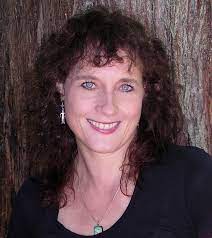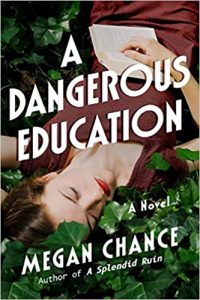The Inspiration Behind A Dangerous Education, by Megan Chance
The Inspiration Behind A Dangerous Education, by Megan Chance
 Ideas have always come easily to me. I get them from everywhere: movies, the news, television, music, other books, research … really, they fly at me endlessly. What isn’t so easy is finding an idea that sticks, or that is big enough to hold its own as a novel. Sometimes it requires combining ideas or circling back to determine what it was about an idea that was so intriguing. Sometimes it’s not what I thought it was at first glance, and it requires more digging to get to the meat of it.
Ideas have always come easily to me. I get them from everywhere: movies, the news, television, music, other books, research … really, they fly at me endlessly. What isn’t so easy is finding an idea that sticks, or that is big enough to hold its own as a novel. Sometimes it requires combining ideas or circling back to determine what it was about an idea that was so intriguing. Sometimes it’s not what I thought it was at first glance, and it requires more digging to get to the meat of it.
In the case of A Dangerous Education, the inspiration was an article I’d read in an old issue of Science News magazine. My mother subscribed to this magazine for a while, and since we share an interest in science, she saved the issues and gave them to me, and so I’d get five or six at a time, sometimes long after they came out.
This happened to be a 2015 issue, and in it was an article on fetal-maternal microchimerism. The article explained that scientists had discovered that women carried DNA from their children in their bloodstream—whether those children had been carried to term or not—and that fetal DNA had been found in women’s organs and brains decades after the fetus was gone. They posited that the DNA passed back and forth between the mother and the fetus. Though they don’t yet know exactly why this happens, or what it means, it’s clear that women are chimeras, in that they carry DNA not just from their mothers, but from their children in their bodies. Women contain multitudes.
Because I have a twisty/turny brain, my very first thought after reading this was the quantum theory of entanglement, or what Einstein called “Spooky Action at a distance.” Entanglement states that once two particles are entwined, they are forever entwined, so that no matter how far apart they are, the moment something happens to one, the other reacts simultaneously in an opposite manner.
I thought: why couldn’t this be true for DNA particles that were once entwined? It explained the almost preternatural connection between mothers and their children, the way women often sense that their children are in trouble or hurting. I could not let go of the idea, and that led me to wonder about women who give up their children for adoption.
A book called The Girls Who Went Away, by Ann Fessler, delved into this question for me. Especially during the 40s through the 1970s, when abortion was illegal, many teenage and unmarried women who got pregnant ended up in unwed mothers’ homes and were forced to give up their children for adoption. The suffering of these women over that decision, which led not only to PTSD that affected them throughout their lives, but which also seemed to have extrasensory elements, kept leading me back to the idea of fetal-maternal microchimerism and entanglement.
At the same time, I had stumbled upon a website that listed the liminal spaces in Seattle, that is, haunted places. One of those was a small park I’d never heard of, Martha Washington Park, which was near where my husband grew up. I discovered that the park was on the site where a juvenile delinquent home for girls had once stood, and that spirits of the girls were said to haunt the park.
Sometimes the ideas that fling themselves at you seem disparate, like cottonwood blossoms scattering through the air with no cohesion or destination. Sometimes, they coalesce in a way that feels like idiocy to turn away from.
I discovered that the Martha Washington School for Girls was a boarding school for juvenile delinquents, variously run by private interests, the Seattle school district and in the 1950s by the state, and that it was abandoned and demolished in the early 80s.
Around the same time, I discovered that there was an unwed mother’s home in Tacoma, Washington, about 30 miles from the site of the Juvenile Delinquent home, and that it had been there from 1890 to 1956, and then served as a maternity hospital until 1987.
I’d long wanted to write a story that had the same kind of feel as Picnic at Hanging Rock, or The Prime of Miss Jean Brodie, and I love dark academia themed books and books that deal with girls in late adolescence and all the uncertainty and strangeness that brings. I was also struggling with jumping from the 19th C into the 20th C. I’d just written a book set during the 1906 San Francisco earthquake, and I was feeling a need to stretch my wings. I’d been reading across broad swaths of 20th C history looking for a place to land, and an author friend, Jayne Ann Krentz, had been telling me for some time that she thought I should consider the 1950s, that she felt it would lend itself well to my voice.
So here was everything pushing me toward the 50s. There were many other serendipitous turns on the road to A Dangerous Education, including some of the incredible things I learned about the curriculum of Home Economics and Sex Ed in the 1950s that became major plot points in the novel. For a historical fiction writer who is constantly inspired by the stories of women and the doors that have been closed to them throughout history, the road to women’s freedom through reproductive choice—but more than that—reproductive knowledge—struck such a responsive chord that there was simply no way I could walk away.
I love all the books I’ve written, but every now and then you end up with a book that feels as if you were meant to write it—even born to write it—and A Dangerous Education feels very much that way to me. I hope you enjoy my foray into the 1950s, and the Catch-22 of women’s choices and their consequences that still seem to echo today.
—
Megan Chance is the best-selling, critically acclaimed author of several novels. Her novel Bone River was an Amazon Book of the Month, A Drop of Ink was an Editors’ Choice of the Historical Novel Society, and An Inconvenient Wife was an IndieNext pick.
Critics love the work of Megan Chance. Booklist calls her writing “Provocative and haunting.” “Magical,” says The Kitsap Sun. “Stellar characterization, terrific dialogue,” praises Publishers Weekly. “Impossible to stop reading,” raves the Seattle Times.
In addition to her historical fiction novels, Chance is the author of the young adult Fianna Trilogy, short stories, and eight historical romance novels. Her novels have been translated into several different languages.
She is also a popular workshop speaker whose speaking credits include the Pacific Northwest Writers Conference, Romance Writers of America National Conference, Edmonds Write on the Sound Conference, the Seattle Assistance League, Timberland Regional Libraries, and many others.
Chance was born in Columbus, Ohio, and moved to Washington State as a girl. She graduated from Western Washington University. Megan lives with her husband in the Pacific Northwest.
Find out more about Megan on her website https://www.meganchance.com/
Follow her on Twitter https://twitter.com/meganschance
Facebook https://www.facebook.com/megan.chance.566
A DANGEROUS EDUCATION
 A reformist teacher. A dangerous student clique. A powerful novel about secrets and redemption set in the shadows of McCarthy-era America.
A reformist teacher. A dangerous student clique. A powerful novel about secrets and redemption set in the shadows of McCarthy-era America.
Rosemary Chivers is haunted by the choices she made as a teenager―and by those made for her by a controlling mother. Now, in the Cold War era of conformity and suspicion, Rosemary is a modern new teacher at a school for troubled girls, where she challenges the narrow curriculum meant to tame restless young minds. She also keeps a devastating secret. She knows one of the students is the child she gave up. But which one?
Ignoring warnings, Rosemary forms an impenetrable bond with the three girls who are the right age: shrewd runaway Maisie, alcohol-indulging Sandra, and overly flirtatious Jean. But these are no ordinary girls, and what begins as an effort to bring closure to her own rebellious youth soon spirals dangerously out of control.
Rosemary is prepared to do anything to find her daughter. What she isn’t prepared for are the deadly consequences that come with discovery―or just how wicked wayward girls can be.
BUY HERE
Category: Contemporary Women Writers, How To and Tips
























